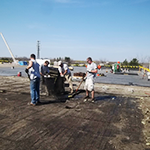On November 17, 2006, Ignite Restaurant Group spun itself off from dining, hospitality, and entertainment powerhouse Landry’s Inc., taking with it the established Joe’s Crab Shack brand. The young, Delaware-based company (which was incorporated in 2002) has since rapidly expanded with new locations and two new brands, and vice president of construction Sean Rea, formerly the director of development for Joe’s Crab Shack when it was owned by Landry’s, has remained on the front lines through it all.
Rea oversees work for each of Ignite’s three dining concepts—Joe’s Crab Shack (a seafood restaurant), Brick House Tavern + Tap (a gastropub), and Romano’s Macaroni Grill (an Italian eatery)—and each is undergoing a period of transition or growth. The Joe’s Crab Shack concept was reworked in 2010 to give it a more polished appearance, and older stores are currently being retrofitted for the new scheme. The Brick House prototype was created internally and introduced into the market less than a year later—a process that Rea says typically takes 18–24 months—and new locations are still going up, particularly in the Northeast. Finally, the Romano’s Macaroni Grill concept was acquired by Ignite just last year, and the company hopes to continue expanding it to add revenue.
 One of Ignite’s most recent successes is a Joe’s Crab Shack in New York City’s Harlem neighborhood. It’s the company’s first foray into the metropolis, and it’s also the first Joe’s Crab Shack to be built in an existing location. “There’s no magic potion,” Rea says, “we don’t do anything differently from anyone, except we do it better, faster, and cheaper by having a hands-on construction department that’s integrated with our other departments.” Here, Rea dispenses some advice for other in-house construction managers working to up their game in the restaurant sector.
One of Ignite’s most recent successes is a Joe’s Crab Shack in New York City’s Harlem neighborhood. It’s the company’s first foray into the metropolis, and it’s also the first Joe’s Crab Shack to be built in an existing location. “There’s no magic potion,” Rea says, “we don’t do anything differently from anyone, except we do it better, faster, and cheaper by having a hands-on construction department that’s integrated with our other departments.” Here, Rea dispenses some advice for other in-house construction managers working to up their game in the restaurant sector.
“We don’t do anything differently from anyone, except we do it better, faster, and cheaper by having a hands-on construction department that’s integrated with our other departments.”
—Sean Rea, VP of Construction
 Have unique concepts and understand their niche. Joe’s is a unique seafood dining experience. We have menu items, buildings, and service models that you can’t get anywhere else in a seafood concept. Brick House is our next-generation sports bar and gastropub, and it includes things you don’t typically see in your everyday sports bar, like fireplaces both inside and outside on the patio. With the Brick House concept, it’s mostly conversions, and on Joe’s we do more ground-up prototype design. It’s just the way the two concepts evolved. Brick House was created as a replacement strategy whereas Joe’s was the concept we bought and continued to develop. Macaroni Grill is the youngest of the three brands, and we’re working through ways to improve that concept.
Have unique concepts and understand their niche. Joe’s is a unique seafood dining experience. We have menu items, buildings, and service models that you can’t get anywhere else in a seafood concept. Brick House is our next-generation sports bar and gastropub, and it includes things you don’t typically see in your everyday sports bar, like fireplaces both inside and outside on the patio. With the Brick House concept, it’s mostly conversions, and on Joe’s we do more ground-up prototype design. It’s just the way the two concepts evolved. Brick House was created as a replacement strategy whereas Joe’s was the concept we bought and continued to develop. Macaroni Grill is the youngest of the three brands, and we’re working through ways to improve that concept.
Be hands-on with construction, and integrate all departments with the process as early as possible. This includes the operations team for each concept, the culinary team for menu rollouts, and the marketing and creative teams for branding and décor. Typically, restaurant departments are very segmented. What we try to do as a development department is establish a connection [between] the design and the project [as we] are moving through the process. So, when we finally do open the restaurant to the public, all of those departments are integrated within the restaurant itself as opposed to them coming in after the fact and trying to add their décor package or their sign package or their operations piece. We just work within each department that affects the restaurant to pull it all together in the design and construction phase.
Work lean by having employees and contractors you can trust. We’re a small company, so we have a preferred group of consultants and vendor partners that we work with. After they have been on board with us, they understand our concepts and our designs. This helps get projects done faster and more efficiently and without having to reinvent the wheel with every project.
Rely on your experience. I’ve taken some lessons from Landry’s and other companies I’ve worked for and integrated those efficiencies into the development process that we currently use. I’ve taken best practices from past experiences and applied them to our process so that everybody has a voice and an understanding of where a project will end. This leads to a seamless transition from the development and construction side to the operations side.
 Keep executives involved. As people move up the corporate ladder, they tend to have less focus on the day-to-day operations of a project, but with the way we’re structured, I am still very hands-on with our projects. That allows us to be quicker at identifying trends and applying those to projects.
Keep executives involved. As people move up the corporate ladder, they tend to have less focus on the day-to-day operations of a project, but with the way we’re structured, I am still very hands-on with our projects. That allows us to be quicker at identifying trends and applying those to projects.
Sean Rea outlines Ignite’s construction process
It all starts with the development or real estate department. They will come with a proposal for a potential new site or an existing site that they feel is right for a conversion to another concept, and they will present that to the executive team. The process doesn’t change drastically based on the type of project that it is presented.
The executive team will bless the initial approval to move forward, and then it will come to me. I take the existing plan or piece of dirt and I either drop our concept prototype on the property or I take the existing building and start to work through the development process of creating the new concept.
From there, I develop a floor plan with a kitchen and a bar, working with our consultants and our internal departments to create the design. Once the floor plan and elevations are created, I will then go to that restaurant concept’s president, and I will present that plan to them, showing them what we’ve created and asking for feedback.
Once that’s done, we go to the city, the county, or the township, and we go through and get the building permits and approvals to build or convert the project into the new Ignite restaurant. That will take weeks or months, depending on what part of the country you’re in.
Then we partner with one of our preferred general contractors and proceed to break ground on the project. I oversee that whole process, up until the point of getting operations in the building so they can train staff.
Thirty to 45 days before the project is ready to turn over, we do an operations walk-through. The project is far enough along so the operations team can walk through the building—the kitchen and the bar—and see how everything is going to lay out. We allow the operations team to modify or change some of the initial design in order to incorporate the way they plan to operate it when they open.
We will stay with that project for the first year after its opening. In the 10th to 12th month of operation, we will come back with the general contractor and the operations team, and we rewalk the project and identify any warranty or contractor items that need to be fixed before the store then becomes responsible for repairs and maintenance.







